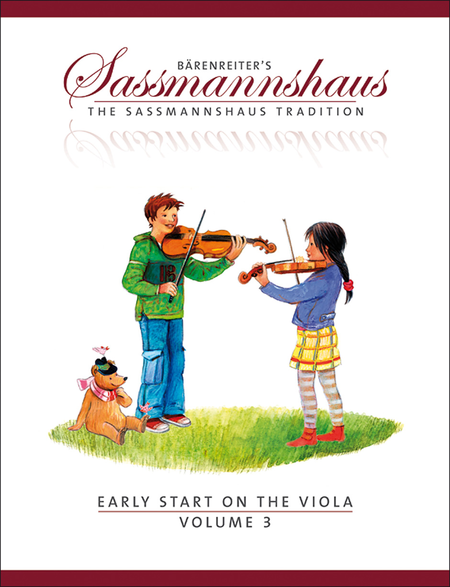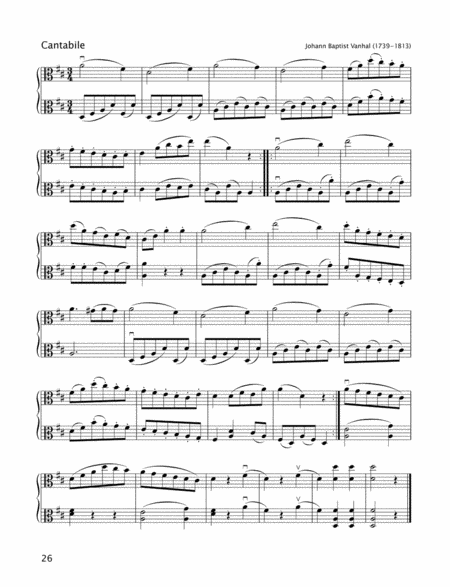Early Start on the Viola, Volume 3
Elementary duets. Dances and other pieces in various keys
-
Ships in 1 to 2 weeks
Details
Description
SKU: BA.BA09688
Elementary duets. Dances and other pieces in various keys. Composed by Egon Saßmannshaus and Kurt Sassmannshaus. Stapled. Barenreiter's Sassmannshaus. Instructional. Performance score. 72 pages. Baerenreiter Verlag #BA09688. Published by Baerenreiter Verlag (BA.BA09688).ISBN 9790006539307. 30 x 23 cm inches. Language: English. Illustrations: Charlotte Panowsky.
The main focus of Volume 3 lies on duet playing in different metres and keys. The variety of the selected recital pieces is designed to encourage fun in music-making and to develop a feeling for contrasting musical styles. On this basis, the familiar finger patterns and bowing strokes are thoroughly practiced and expanded. Learners also encounter fundamental ornaments (trills, appoggiaturas, upper mordents) and a new rhythmic unit: the triplet.
A table on the inside back cover lists page numbers for all the duets contained in this volume and in Volume 3 of the cello tutor “Früher Anfang auf dem Cello” (BA 9693), making it possible to play the pieces with viola and cello.
The authors
In 1976 Egon Sassmannshaus, one of the most experienced and renowned violin teachers in Germany, published his tutor “Früher Anfang auf der Bratsche”. This standard work for young string players quickly became the most popular and best-selling tutor in the German-speaking countries for beginners on the viola. His son Kurt Sassmannshaus functioned as co-editor of the English-language edition, “Early Start on the Viola” (BA 9686, BA 9687, BA 9688, BA 9689), adapting his father's successful tutor to meet the needs and requirements of English-speaking children.
The combined knowledge and experience of both father and son make these four volumes the most thoroughly researched and thought-through viola tutor for beginners all over the world.
About Baerenreiter's Sassmannshaus
Children playfully learn reliable technique at the earliest age. For more than three decades the Sassmannshaus Tradition has been the household name for excellence in beginner methods in German-speaking countries. More than half a million students have successfully learned to play using this publication.
This tried and tested German method is now available in English! The best-selling method that gave generations of European musicians their foundation is now available in English, with content and songs newly adapted for today's English speaking children.
What makes this method so special?
- The child-friendly and age-appropriate text underlying the music enables children to perceive melodies as a whole and to understand their singable qualities.
- Songs and scales in different positions are easily explained and mastered within the first year. This is an important advantage over methods that confine children to the first position for many years.
- Note reading is emphasized from the first lesson - children are brought up to become proficient sight-readers and play in chamber music ensembles as early as possible.
- In contrast to other beginner methods, The Sassmannshaus Tradition progresses swiftly by introducing advanced techniques in rudimentary form, such as shifting and varied bow strokes.
- Ensemble playing is encouraged from the very beginning.
- The method is suitable for single instruction as well as for group and class lessons.
- The large print notes and text as well as many colorful illustrations are particularly child-friendly and very attractive to pre-school children and school children alike.
- The substantial volumes contain comprehensive material and carefully calibrated learning curves. They keep children curious and interested for many months and years.
Song List (16)
- Preface
- The Half Step Is Between The Second And Third Fingers
- Ornaments
- The Half Step Is Between the First and Second fingers
- The Second Finger Changes Between Low And High Positions
- The Half Step Is Between the Third and Fourth Fingers
- The Third Finger changes Between Low And High Positions
- The First Finger Is Low
- The First Finger Changes Between Low And High Positions
- Finger Patterns, Old And New
- The Fourth Finger Is In Low Position
- The Fourth Finger Changes Between Low And High Positions
- Triplets
- Duets In Various Keys With Changing Finger Patterns
- Major and Minor Scales
- Helpful Hints For Violinists


 Share
Share